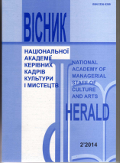CONTINUITY OF CULTURES AS A MECHANISM OF TRANSFORMATION OF VALUE ORIENTATIONS OF YOUTH
DOI:
https://doi.org/10.32461/2226-3209.2.2014.137935Keywords:
continuity of cultures, value orientations, youth, youth subculturesAbstract
The article is devoted to the nature and features of transformation of value orientations among young people in the context of continuity of cultures. The problem of the research is to determine the mechanisms of continuity of culture and their influence on the formation of value orientations of modern youth.
The article investigates the mechanisms of continuity of cultural experience and clarified the main factors of inheritance culture. Considered the problems of studying the transformation of valuable core of culture in the context of continuity of cultures. The mechanisms of continuity of culture, namely the processes of socialization and enculturation of youth. Analyzed the influence of modern social and cultural reality to intensify innovative, creative possibilities (potency) youth. Find out the main factors of the historical discrepancies seniors rapidly changing socio-cultural reality. The features of mutual influence of elderly and youth subcultures and argued further likely parameters of joint development.
The depth of the socio-cultural transformations inUkraineis actually motivating factor to examine the direction of this process and the likely vectors of its development; determine the specificity of transformation and, respectively, expected results. Basis for the study of this issue is the analysis of the most dynamic social groups – youth subcultures.
Relevance of research of the transformation of value orientations is due necessity of comprehension mechanism continuity of culture and transformation of the valuable core culture. Problems of value orientations of modern youth is considered from the standpoint of understanding the process of identity in a rapidly changing reality, during the crisis of culture and projection postmodern ideas in the minds of the younger generation.
Embodying innovation and creativity, youth subculture has attracted the attention of researchers, as discussed in the context of future innovations initiator and main factor of transformations. Adequacy of Ukrainian youth public scale of social tasks can be elucidated in studies of its value orientations.
Putting innovation and creativity, youth subculture has attracted the attention of researchers, as seen in the context of future innovations initiator and main factor of change. Adequacy Ukrainian youth of scale social problems can be clarified in the study of values. In the new social and cultural realities experience of young people differ radically from the values of the older generation views. Youth subcultures, as a progressive social stratum, create directly new life guidance, pattern of behavior, values, idea of success and the meaning of life.
Attempts of the older generation overcome, to refute the latest trends of the culture are unavailing efforts and unfounded. Old culture disappears gradually. Old traditions and rituals become a thing of the past. Entire social order life changing. Forgotten culture, losing its integrity, is only a fragment of a new life. Instead, new generation embodies and transmits the new living arrangement most fully.
Thus, another world view, which is inherent of the new generation, the new youth subculture, other values and goals are cause displacement vital guideline, which activates the mechanism of transformation of values fundamentals of culture.
Downloads
Published
Issue
Section
License
Authors who publish with this journal agree to the following terms:
1. Authors retain copyright and grant the journal right of first publication with the work simultaneously licensed under a Creative Commons Attribution License that allows others to share the work with an acknowledgement of the work's authorship and initial publication in this journal.
2. Authors are able to enter into separate, additional contractual arrangements for the non-exclusive distribution of the journal's published version of the work (e.g., post it to an institutional repository or publish it in a book), with an acknowledgement of its initial publication in this journal.
3. Authors are permitted and encouraged to post their work online (e.g., in institutional repositories or on their website) prior to and during the submission process, as it can lead to productive exchanges, as well as earlier and greater citation of published work (See The Effect of Open Access).


